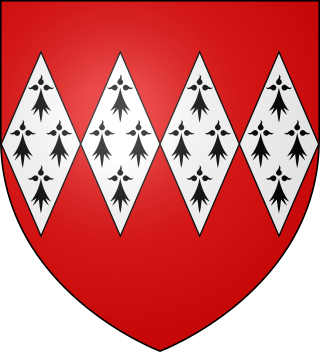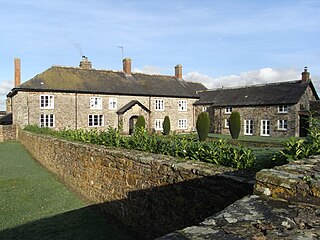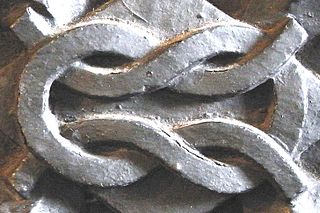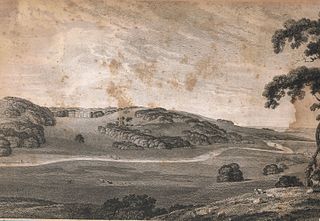
John Bourchier, 1st Earl of Bath (20 July 1470 – 30 April 1539) was named Earl of Bath in 1536. He was feudal baron of Bampton in Devon.

John Bourchier, 1st Earl of Bath (20 July 1470 – 30 April 1539) was named Earl of Bath in 1536. He was feudal baron of Bampton in Devon.
John Bourchier was born in Essex, England, the eldest son and heir of Fulk Bourchier, 10th Baron FitzWarin (d. 18 September 1479) [1] by his wife Elizabeth Dynham, 2nd daughter and co-heiress of John Dynham, 6th Baron Dynham. [2] He was the brother of Elizabeth Bourchier.[ citation needed ]
Bourchier married three times:

By his 1st wife Cecily Daubeny, he had the following children:
John Bourchier, 1st Earl of Bath was buried in Bampton Church in Devon, in which he had endowed a chantry. Although part of an elaborate chest tomb survives in the church, it is according to Pevsner that of his grandmother Thomasine Hankford (d.1453), heiress of Bampton, wife of William Bourchier, 9th Baron FitzWarin (1407–1470). [10] The 1st Earl's tomb, which was destroyed sometime after 1770, was situated in the north aisle of Bampton Church and showed effigies of himself and his wife Cecily Daubeny with their 8 children. [11]

John Bourchier, 1st Baron Berners, KG was an English peer.

John Bourchier, 2nd Earl of Bath was an Earl in the peerage of England. He also succeeded to the titles of 12th Baron FitzWarin, Baron Daubeney and 4th Count of Eu.

Edward Bourchier, 4th Earl of Bath.

James Tuchet, 7th Baron Audley was a British nobleman and the only lord to fully join the Cornish rebellion of 1497 opposing the rule of Henry VII of England. He was a leader in the rebel army's march to the edge of London, and in its defeat at the Battle of Deptford Bridge. Captured on the battlefield, he was sentenced for treason and beheaded. His peerage was forfeited, but restored to his son in 1512.

Fulk Bourchier, 10th Baron FitzWarin was the son and heir of William Bourchier, 9th Baron FitzWarin (1407–1470) and the father of John Bourchier, 1st Earl of Bath. He was feudal baron of Bampton in Devon.

Baron FitzWarin was a title in the Peerage of England created by writ of summons for Fulk V FitzWarin in 1295. His family had been magnates for nearly a century, at least since 1205 when his grandfather Fulk III FitzWarin obtained Whittington Castle near Oswestry, which was their main residence and the seat of a marcher lordship.

Edward de Courtenay, 3rd/11th Earl of Devon, known by the epithet the "Blind Earl", was the son of Sir Edward de Courtenay and Emeline Dawnay, and in 1377 succeeded his grandfather, Hugh Courtenay, 10th Earl of Devon, as Earl of Devon. The ordinal number given to the early Courtenay Earls of Devon depends on whether the earldom is deemed a new creation by the letters patent granted 22 February 1334/5 or whether it is deemed a restitution of the old dignity of the de Redvers family. Authorities differ in their opinions, and thus alternative ordinal numbers exist, given here.

John Dynham, 1st Baron Dynham, KG of Nutwell in the parish of Woodbury and of Hartland, both in Devon, was an English peer and politician. He served as Lord High Treasurer of England and Lord Chancellor of Ireland. He was one of the few men to have served as councillor to Kings Edward IV, Richard III and Henry VII and was trusted by all of them.

Mary Arundell, Countess of Arundel, was an English courtier. She was the only child of Sir John Arundell of Lanherne, Cornwall, by his second wife, Katherine Grenville. She was a gentlewoman at court in the reign of King Henry VIII, serving two of Henry VIII's Queens, and the King's daughter, Princess Mary. She was traditionally believed to have been "the erudite Mary Arundell", the supposed translator of verses now known to have been the work of her stepdaughter, Mary FitzAlan, later the first wife of Thomas Howard, 4th Duke of Norfolk.
Elizabeth Bourchier was an English noblewoman. She was, by her third husband, Sir Edward Stanhope, the mother of Anne Stanhope, wife of the Protector Somerset. Her fourth husband was the courtier Sir Richard Page. She died in 1557, and was buried at Clerkenwell.

Brightley was historically the principal secondary estate within the parish and former manor of Chittlehampton in the county of Devon, England, situated about 2 1/4 miles south-west of the church and on a hillside above the River Taw. From the early 16th century to 1715 it was the seat of the Giffard family, whose mansion house occupied the moated site immediately to the west of the present large farmhouse known as Brightley Barton, a Grade II listed building which incorporates some elements of the earlier house. It is not to be confused with the 12th-century Brightley Priory near Okehampton.

Sir John Arundell (1474–1545) Knight Banneret, of Lanherne, St Mawgan-in-Pyder, Cornwall, was "the most important man in the county", being Receiver-General of the Duchy of Cornwall. His monumental brass in the church at St Columb Major in Cornwall was described by Dunkin (1882) as "perhaps the most elaborate and interesting brass to be found in Cornwall".

The feudal barony of Bampton was one of eight feudal baronies in Devonshire which existed during the mediaeval era, and had its caput at Bampton Castle within the manor of Bampton.

Sir John Dinham (1406–1458) was a knight from Devonshire, England. His principal seats were at Nutwell and Kingskerswell in South Devon and Hartland in North Devon.

William Bourchier (1407–1470) jure uxoris 9th Baron FitzWarin, was an English nobleman. He was summoned to Parliament in 1448 as Baron FitzWarin in right of his wife Thomasine Hankford.

The Bourchier knot is a variety of heraldic knot. It was used as a heraldic badge by the Bourchier family, whose earliest prominent ancestor in England was John de Bourchier, a Judge of the Common Pleas, seated at Stanstead Hall in the parish of Halstead, Essex. He was the father of Robert Bourchier, 1st Baron Bourchier (d.1349), Lord Chancellor of England. The various branches of his descendants held the titles Baron Bourchier, Count of Eu, Viscount Bourchier, Earl of Essex, Baron Berners, Baron FitzWarin and Earl of Bath. The knot should perhaps have been called the "FitzWarin knot" as according to Boutell (1864) the device was first used by the FitzWarin family, whose heir was the Bourchier family.
The Manor of Shirwell was a manor in North Devon, England, centred on the village of Shirwell and largely co-terminous with the parish of Shirwell. It was for many centuries successively the seat of two of the leading families of North Devon, the Beaumonts and their heirs the Chichesters of Raleigh, Pilton, both of which families were seated at the estate of Youlston within the manor of Shirwell. The manor house which survives today known as Youlston Park is one of the most architecturally important historic houses in North Devon and exists largely in its Georgian form, but retains many impressive late 17th-century interiors.

Ash in the parish of Braunton in North Devon is a historic estate listed in the Domesday Book. The present mansion, known as The Ash Barton estate is a Grade II* listed building.

The historic manor of Tawstock was situated in North Devon, in the hundred of Fremington, 2 miles south of Barnstaple, England. According to Pole the feudal baron of Barnstaple Henry de Tracy made Tawstock his seat, apparently having abandoned Barnstaple Castle as the chief residence of the barony. Many of the historic lords of the manor are commemorated by monuments in St Peter's Church, the parish church of Tawstock which in the opinion of Pevsner contains "the best collection in the county apart from those in the cathedral", and in the opinion of Hoskins "contains the finest collection of monuments in Devon and one of the most notable in England".
Lady Eleanor Arundell, was an English noblewoman, and the first wife of Sir John Arundell of Lanherne in Cornwall, "the most important man in the county", being Receiver-General of the Duchy of Cornwall. Their monumental brass in the church at St Columb Major in Cornwall was described by E. H. W. Dunkin (1882) as "perhaps the most elaborate and interesting brass to be found in Cornwall." Her father was Thomas Grey, 1st Marquess of Dorset. Eleanor was an ancestor of the later Barons Arundell of Wardour.